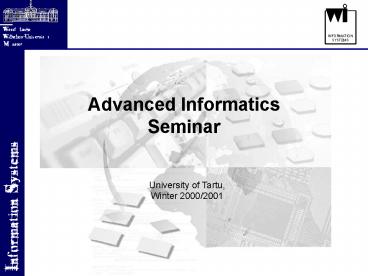Advanced Informatics Seminar - PowerPoint PPT Presentation
1 / 28
Title:
Advanced Informatics Seminar
Description:
A data warehouse is a subject oriented, integrated, nonvolatile, and time ... Focusses customer orientation, but: not maximizing customer orientation! ... – PowerPoint PPT presentation
Number of Views:80
Avg rating:3.0/5.0
Title: Advanced Informatics Seminar
1
Advanced InformaticsSeminar
University of Tartu, Winter 2000/2001
2
Data Warehousing and Data Mining
3
Where to find the information?
- no time basis of data
- ad-hoc calculation impossible
- the levels of detail
- the problem of external data
- no common source of data to begin with
?
Report
?
decision maker
operative systems (TPS)
4
Data Warehouse- Definition
- A data warehouse is a subject oriented,
integrated, nonvolatile, and time variant
collection of data in support of managements
decisions.
Inmon (1996), p. 33.
5
Design the Data Warehouse
- the two major aspects of building of a data
warehouse
interfaces to the operational systems
design of the data warehouse itself
? meta data
6
MIS requirement definitioninformation objects
product group
Structure of reference objects
hardware
printers
computers
Reference object(year, product group,
customer, )
Informationobject
sales peryear 2000,product group
printers, customer all
Ratio number (sales)
7
Technical MIS-architecture
- Data Warehouse
- Database for
- Management Information System
end user / analysis tools
OLAP
Data Mining Tools
Reporting
ABC, Portfolio-Analyis
modelling and administration
Data Warehouse
Management
Subject-oriented data marts
Data Warehouse
Tool
Meta data
extraction and transformation
external data
Operative Systems(TPS)
8
MIS requirement definitionreport definition
?
Report
decision maker
9
OLAPOnline Analytical Processing
- Relational model was not designed for data
synthesis, analysis, and consolidation - This is the role of spreadsheets and other
special purpose software - Need to complement RDBMS technology with a
multidimensional view of data
10
A hypercube
A B C ...
customer
Sales
juice coke milch ... ... ... ... ... apples grapes
banana
product
Dec. ... ... ... ... ... ... ... ... ... Febr. Jan
uary
Time
11
Star Scheme
To minimize number of joins, data warehouse model
can be denormalized
Fact Table
12
Drill Down
reference object
reference number
detailled information
13
Possible Topics
- Potentials of Data Warehousing in Electronic
Commerce - Data Warehouse as Enabling Technology for
Balanced Scorecards - Data Mining in Business Applications State of
the Art and Trends - Principles of Multi-Dimensional Databases
14
Internet and Electronic Commerce
15
Internet and Electronic CommercePhases of
Transactions
Information and Decision Phase
Negotiation Phase
Performance Phase
Search for market partners and alternatives
Communicate about terms of conditions
Exchange good Payment
16
Internet and Electronic Commerce(Exampe Market
Place)
17
Possible Topics
- Theoretical Foundations of Electronic Commerce
- Personalization Approaches for Internet Portals
- Payment Models for Electronic Commerce
- Characterization of Electronic Market Places
18
Knowledge Management
19
Knowledge Management
20
Content Management
21
Possible Topics
- Methods and Tools for Knowledge Management
- Development of Content Management Systems
22
Other Topics
- Methods of ERP System Selection
- Information Flows in ECR Co-operations
- Features of Customer Relationship Management
Systems
23
Methods of ERP System Selection(Example SAP R/3)
Enterprise Management
StrategicEnterpriseManagement
Business Intelligence Data Warehousing
Managerial Accounting
FinancialAccounting
Customer Relationship Management
Sales Channels
Sales Management
Service Agreements
Customer Service
Service Fulfillment
Product/Brand Marketing
Product Design Engineering
Computer Aided Design
Component Specification
Product Option Specification
Product Data Management
Manufacturing Process Specification
Engineering Change Management
Supply Chain Planning
Sales Demand Planning
Operations Planning
Distribution Planning
Component Procurement
Quality Evaluation
Component Supplier Selection
Purchasing Contracts
Electronic Procurement
Manufacturing
Production Scheduling
Production Execution
Quality Management
Plant Maintenance
Sales Distribution
Sales Cycle Management
Order Fulfillment
Distributor Reseller Management
Warehouse Management
Transportation Management
Customer Service
Installation Management
Field Service Support
Service History
Service Configuration Management
Billing/Costing/Profitability
Service Supply Chain Management
Business Support
Human Resource Management
Procurement
Treasury
Fixed Asset Management
Software Management
Foreign Trade Management
24
Methods of ERP System Selection(Example
PSIPenta)
25
ECR Pyramid
Interorganizational Information Flows in ECR
Cooperations
Efficient Product Innovation Efficient
Promotion Efficient Assortment Efficient
Administration Efficient Replenishment Efficient
Standards
Coope- rative Marketing
Logistics (SCM)
26
Interorganizational InformationFlows in ECR
Cooperations
Wholesale trade/ Retailing Company
shared product development
Industry
Delivery order
Sales data
shared product develop- ment
Delivery order
Sales data
Supplier
27
Features of Customer Relationship Management
Systems
- Definition Customer Relationship Management is
the continuous creation and maintenance of
customer relations, oriented at enterprise
objectives (e.g. profit) - Includes
- strategic functions (e.g. market segmentation)
- operational functions (e.g. order processing)
- Focusses customer orientation, but
- not maximizing customer orientation!
- as much customer orientation as necessary, as
little as possible - CRM tries to determine the optimal degree of
customer orientation (-gt individualization) - complexity costs of increasing individualization
caused by increased number of process variants
28
Features of Customer Relationship Management
Systems
Customer Life Cycle
2. Order Processing
3. After Sales
1. Acquisition
- 1. Acquisition
- First contact with customer
- Creation of first impression / company image
- least knowledge about customer (anonymous market)
- However Individual presentation required
29
Features of Customer Relationship Management
Systems
- 2. Order Processing
- Reception and processing of customer order /
request - Already high degree of IT support (modules for
material management, sales and distribution,
production planning etc.) - CRM requires
- integration of customer-related data from
different sources - possibilities to analyze links between customer
and product data (identify customers causing
increased product/process complexity)
30
Features of Customer Relationship Management
Systems
- 3. After Sales
- Highest potential for CRM. Includes
- Inquiry of customer satisfaction
- complaint management
- customer support
- identify potential re-buyers and buyers of
supplementary services or products - drop likely non-re-buyers as soon as possible
- Independent offering of additional services,
substitution parts etc. (generation of secondary
revenues), enabled by analysis of - average maintenance intervals,
- average product lifetime
- customer behavior,
- IT requirements Analysis of demographic data
constant improvement of market segmentation






























